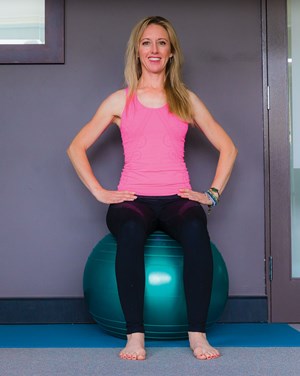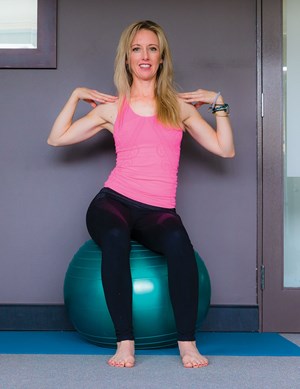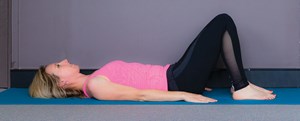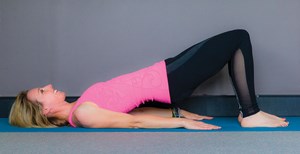Now that you have had some practice finding your core (January 2015), we are going to look at the mobility of your back and pelvis.
These exercises will help you to locate any blockages in the muscles of your pelvis and back. They also help to disassociate the upper and lower body. This is beneficial because the pelvis, in part, belongs to the horse while the shoulder girdle, also known as the top half of the torso, belongs to the rider. The pelvis has to be stable to support the backbone, but it also must have controlled mobility to move with the horse in a three-dimensional manner. If the pelvis is not able to do this, the flow of movement through the horse’s back is blocked, leading to a stiff and possibly hollow back in both the horse and rider. The rider’s back also needs to be able to guide the horse through the extended as well as collected paces. The lower body of the rider should be constantly making small adjustments to remain in balance with the horse. This allows the rider’s upper body to float effortlessly on top.
Pelvic Mobility Using a Stability Ball
It is important to do these exercises in a slow and controlled fashion, allowing for good use of your muscles over the entire range of the movement. Make sure that you do not bypass overly tight or loose areas simply using momentum. The body needs time to compute where the blockages are and what muscles it needs to stretch or contract to eliminate the imbalance. We are looking for evenness in all directions.
Set up:

1. Findaneutral spine, sitting on the ball, with your feet hip-width apart.
2. Relax your legs and arms.
3. As you breathe in, switch on your core by imagining the lower abs melting inward toward your spine and lifting up gently through the pelvic floor. When breathing, imagine filling up your lungs completely, including the sides and back, not just the front. Your shoulders should remain relaxed and still.
Pelvic tilts back and forward: Sit on a stability ball with your feet parallel and hip-width apart and with equal weight on both seat bones. Keeping your shoulders still, tilt your pelvis gently forward and back. Be careful not to tilt your pelvis too much (increasing the hollow in the lower back excessively), which puts pressure on the vertebrae of your lower back. This is why it is very important to keep the core well switched on.
Sideways pelvic tilts: Resume the same start position with your feet parallel and hip-width apart and with equal weight in both seat bones. I like to put my hands on my shoulders to make sure they are not moving, but if you find you tense your shoulders while doing this, let your arms hang loosely at your sides. Rock your pelvis from side to side, maintaining length through your torso. Think of keeping your shoulders still. Don’t be like a wobble doll with your shoulders swaying all over the place. Bring your ribs and hips closer together on the side you are compressing. Keep the ribs over your hips and don’t let them pop out one side or the other.

Hip circles: Move your hips in a big circle around your shoulders, which remain still and centered. Check for any areas that feel blocked or where you want to cut corners and lose the correct circumference of the circle.
Things to avoid:
• Moving your shoulders or hunching, rather than allowing your waist and core to do the work
• Holding your breath
• Asymmetrical movements
• Losing length through your body and collapsing your ribs
Shoulder Bridge

This is a wonderful exercise to remove blockages in your spine. If your back is locked in any place, the movement of the horse will not be absorbed by the natural curvature of your spine and the muscles supporting it. This exercise also opens the front of your hips to help achieve a good dressage position, teaches you to relax your shoulders, disassociating them from your pelvis and torso, and has the added benefit of massaging the central nervous system, which helps balance you mentally as well as physically.
Set up:
1. Lie on your back with your knees bent and a neutral spine.
2. Switch off the big muscles of your legs and engage your core.
Performing the shoulder bridge: Start the movement by lifting your seat. Peel your vertebrae off the floor one at a time until your body makes a diagonal line. (Does this feel familiar? You’re in a dressage position, connecting the front of the body and opening the front of your hips.) Roll back down to the start position one vertebrae at a time.

Things to avoid:
• Nonsequential movement in your spine or flattening your back
• Tilting your pelvis, favoring one side, which keeps you from remaining straight
• Hunching your shoulders
• Pushing your tummy out and not keeping the front of your body connected
Rebecca Ashton is a qualified Pilates instructor, a British Horse Society-trained instructor and an Equestrian Australia-accredited dressage coach. She has competed through Intermediaire II, working with riders such as Anky van Grunsven and earning championship titles in the small tour. She lives in Australia and teaches clinics internationally (equestelite.com).













